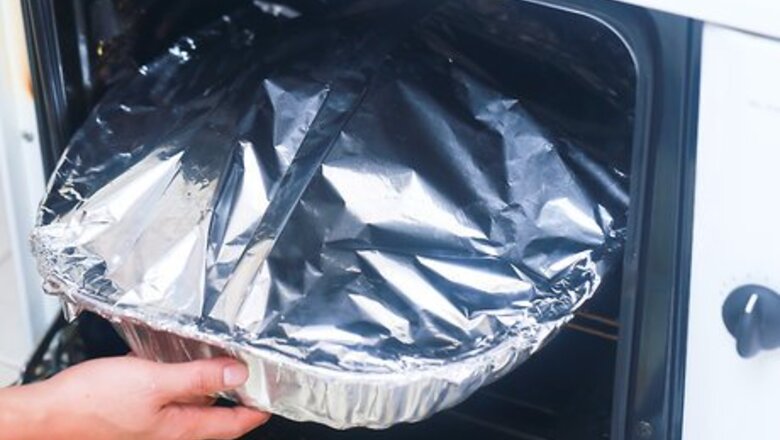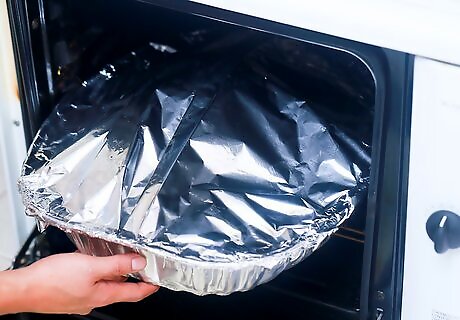
views
Cooking a Spiral Sliced Ham
Thaw the ham if necessary. If you purchased a frozen spiral-cut ham, keep it in the airtight packaging and thaw it for two or three days in the refrigerator. A small ham can instead be submerged in cold water and thawed in two or three hours, replacing the water with fresh, cold water every half hour. You can cook the ham without thawing, but it will take approximately 1.5 times as long to cook as a thawed ham.
Check the label. Check the label on your ham. Most store-bought spiral-cut hams are "ready to eat," but you may still want to follow the cooking instructions below to warm it up. If the ham is "ready to cook," you must cook it before it is safe to eat.
Wrap the ham and baking sheet in aluminum foil. Remove all packaging from the ham and wrap it in foil to seal in moisture during cooking. Line a baking sheet with foil as well. If you really hate dry ham, place a second baking sheet on a lower rack of the oven and fill it with water.

Cook the ham. Set the wrapped ham cut-side down on the baking sheet. Preheat the oven and time the cooking process depending on the state it was in when you began, checking once every 20–30 minutes for the beginning of overdone, dry edges: Ready to eat hams just need to be warmed up. To keep it moist, heat in a 250ºF (120ºC), for approximately 20 minutes per pound (0.45 kg). To speed up the process at the cost of some moisture, heat at 350ºF (175ºC) instead for 10 minutes per pound (0.45 kg). Test with a meat thermometer if you have one, until internal temperature reaches about 120ºF (50ºC). Ready to cook hams are only partially cooked, and should reach an internal temperature of at least 145ºF (60ºC), then removed from the oven and left alone for three minutes while cooking completes. This typically takes 20 minutes per pound (0.45 kg) in a 325ºF (160ºC) oven. Fresh (raw) ham is rarely sold as a spiral cut, but if you have the exception, cook for approximately 25 minutes per pound (0.45 kg) in a 325ºF (160ºC) oven, until the internal temperature is at least 145ºF (60ºC). Let sit for a few minutes while cooking completes, before carving.
Glaze the ham. This is best done 30 minutes before the ham is finished cooking, or once a fresh or "ready to cook" ham has reached an internal temperature of 145ºF (60ºC). Score the ham with a diagonal pattern using a knife and brush on the glaze of your choice, then return the ham to the oven for another 30 minutes. Scoring the ham before applying the glaze helps create a greater surface area, allowing the ham to better absorb the flavors and ensuring that the glaze sticks better to the ham. Most store-bought spiral-cut hams come with their own glaze power, which can be mixed with water to form the glaze. To make your own simple glaze, mix equal parts brown sugar and mustard. Use honey mustard for a sweeter glaze, or Dijon mustard for a more acidic flavor.
Carving a Spiral-Cut Ham into Slices
Cut along a natural muscle seam. Place your ham cut-side up on your cutting board and examine the pink, cut surface. The ham should have three visible "seams" of connective tissue between the pink muscle. These are either white or reddish pink. Cut along one of these seams from the outer edge all the way to the center. For best results, use a flexible meat carving knife with hollow ovals or scallops cut next to the blade edge. Some boneless hams contain significant amounts of ground meat reshaped into a ham, and may not have visible seams. In this case, carve through to the center from any point on the edge, then repeat with two more slices to divide it into three pieces.
Cut up along the second muscle seam. If a bone is present, cut in a close circle around it until you reach the second muscle seam. Cut outward along this seam to release the first stack of slices.
Cut the third seam. The final seam will divide the remaining ham into two stacks of slices. Cut all the way around the bone in a tight circle to release them. Arrange slices on a serving platter or transfer directly to guests' plates. If the ham is large, cut the stack of slices in half before serving.




















Comments
0 comment